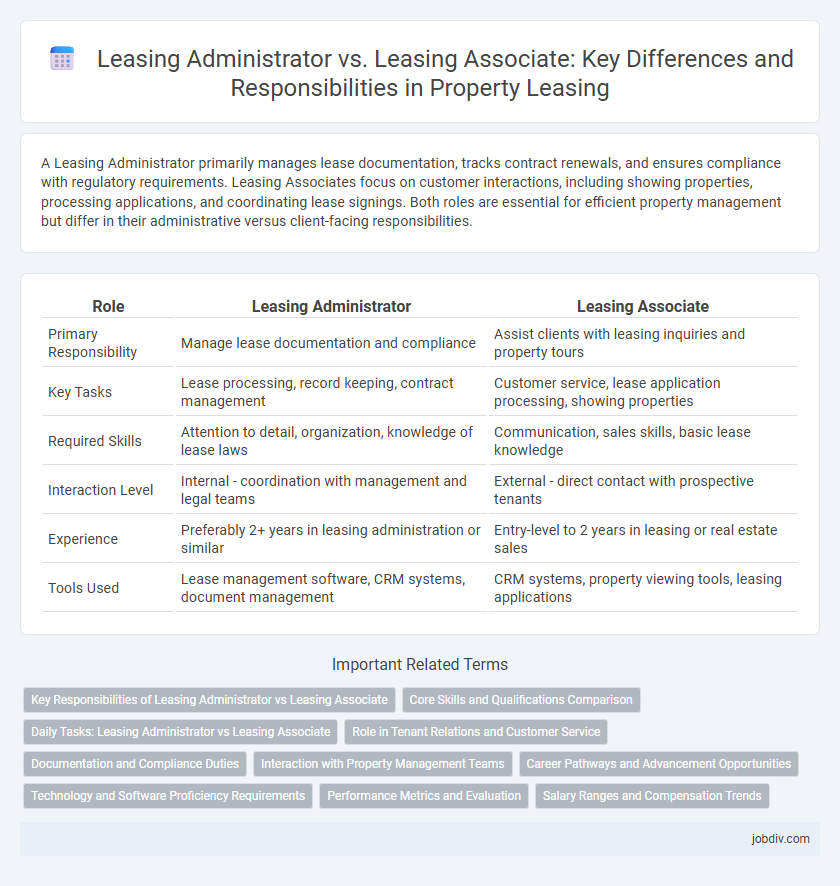A Leasing Administrator primarily manages lease documentation, tracks contract renewals, and ensures compliance with regulatory requirements. Leasing Associates focus on customer interactions, including showing properties, processing applications, and coordinating lease signings. Both roles are essential for efficient property management but differ in their administrative versus client-facing responsibilities.
Table of Comparison
| Role | Leasing Administrator | Leasing Associate |
|---|---|---|
| Primary Responsibility | Manage lease documentation and compliance | Assist clients with leasing inquiries and property tours |
| Key Tasks | Lease processing, record keeping, contract management | Customer service, lease application processing, showing properties |
| Required Skills | Attention to detail, organization, knowledge of lease laws | Communication, sales skills, basic lease knowledge |
| Interaction Level | Internal - coordination with management and legal teams | External - direct contact with prospective tenants |
| Experience | Preferably 2+ years in leasing administration or similar | Entry-level to 2 years in leasing or real estate sales |
| Tools Used | Lease management software, CRM systems, document management | CRM systems, property viewing tools, leasing applications |
Key Responsibilities of Leasing Administrator vs Leasing Associate
Leasing Administrators handle lease documentation management, ensuring compliance and accurate record-keeping, while Leasing Associates focus on client interactions, property showings, and processing lease applications. Leasing Administrators coordinate with legal teams and manage lease renewals, whereas Leasing Associates facilitate tenant communications and assist with marketing rental units. Both roles support lease administration but differ in operational and customer service emphasis.
Core Skills and Qualifications Comparison
Leasing Administrators possess advanced expertise in contract management, lease compliance, and tenant relations, often requiring proficiency in property management software and knowledge of legal regulations. Leasing Associates focus on customer service skills, marketing properties, and conducting property tours, emphasizing strong communication and sales abilities. Both roles demand attention to detail and organizational skills, but Leasing Administrators typically require more experience in administrative oversight and lease documentation.
Daily Tasks: Leasing Administrator vs Leasing Associate
Leasing Administrators manage lease documentation, verify tenant information, and coordinate renewals to ensure compliance and organized records. Leasing Associates focus on client interactions, conducting property tours, processing applications, and addressing tenant inquiries to support lease agreements. Both roles streamline leasing operations, with administrators handling backend processes and associates managing front-line tenant relations.
Role in Tenant Relations and Customer Service
Leasing Administrators primarily manage lease documentation and ensure compliance, serving as the main point of contact for tenant inquiries and resolving contractual issues efficiently. Leasing Associates focus more on customer service, guiding prospective tenants through the leasing process, conducting property tours, and facilitating lease signings to enhance tenant satisfaction. Both roles collaborate closely to maintain positive tenant relationships and streamline communication between management and tenants.
Documentation and Compliance Duties
Leasing Administrators handle comprehensive documentation management, ensuring all lease agreements comply with regulatory standards and internal policies. Leasing Associates process initial lease paperwork, verify tenant information, and assist in maintaining accurate compliance records. The administrator role requires deeper oversight of legal documentation and audit readiness, while associates focus on supporting data entry and compliance tracking tasks.
Interaction with Property Management Teams
A Leasing Administrator coordinates closely with property management teams to streamline lease documentation, compliance tracking, and rent collection processes. Leasing Associates focus on fostering tenant relations and assisting property managers with scheduling viewings, processing applications, and addressing initial tenant inquiries. Both roles require effective communication and collaboration to ensure smooth property operations and tenant satisfaction.
Career Pathways and Advancement Opportunities
Leasing Administrators typically manage contract documentation and compliance, serving as a critical support role in property management, which can lead to advancement into Senior Leasing Administrator or Leasing Manager positions. Leasing Associates focus on tenant relations and lease negotiations, building direct customer service skills that pave the way to roles like Leasing Consultant or Property Manager. Both positions offer distinct career pathways, with Leasing Administrator roles leaning toward operational management and Leasing Associate roles emphasizing client interaction and sales expertise.
Technology and Software Proficiency Requirements
Leasing Administrators typically require advanced proficiency in property management software such as Yardi, RealPage, and MRI, along with strong skills in data analysis and CRM platforms to manage lease documentation and tenant communications efficiently. Leasing Associates often use leasing-specific tools like Dotloop or LeaseHawk, emphasizing user-friendly systems for scheduling appointments and processing applications, requiring moderate technical skills. Both roles benefit from familiarity with Microsoft Office Suite and electronic signature software, but Administrators generally handle more complex software integration and reporting functions.
Performance Metrics and Evaluation
Leasing Administrators are evaluated based on accuracy in lease documentation, compliance adherence, and timely processing of lease agreements, reflecting their role in administrative precision. Leasing Associates' performance metrics emphasize tenant acquisition rates, lease renewals, and customer service effectiveness, highlighting their direct interaction with clients and lease negotiations. Both roles require tracking key performance indicators such as lease turnover times and occupancy rates to optimize property management outcomes.
Salary Ranges and Compensation Trends
Leasing Administrators typically earn between $40,000 and $55,000 annually, reflecting their more specialized responsibilities in lease management and compliance. Leasing Associates generally have a salary range of $30,000 to $45,000, influenced by entry-level duties and customer interactions. Recent compensation trends indicate steady growth in Leasing Administrator salaries due to increased demand for regulatory expertise, while Leasing Associate wages remain competitive with performance-based incentives.
Leasing Administrator vs Leasing Associate Infographic

 jobdiv.com
jobdiv.com